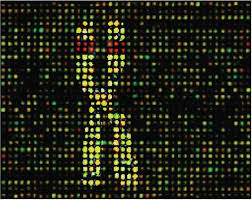Cytogenetics is a branch of genetics that studies the structure and function of the cell, especially normal and abnormal chromosomes. The study includes examination of chromosome structure, learning and describing the relationships between chromosome structure and phenotype, seeking out the causes of chromosomal abnormalities, as well as molecular cytogenetics such as fluorescent in situ hybridization (FISH) and comparative genomic hybridization (CGH).
Changes that affect the number and/or structure of the chromosomes can cause problems with body functions, growth and development. Cytogenetic analyses are commonly examined during pregnancy to determine if a fetus is at risk for common aneuplodies. And the same cytogenetic analyses can be performed on a newborn or child with multiple anomalies or developmental delays to look for a potential chromosomal abnormality.
Karyotyping, a routine chromosome analysis, refers to analysis of metaphase chromosomes which have been banded using trypsin followed by Giemsa, Leishmanns, or a mixture of both. This creates banding patterns on the chromosomes which allows the detection of less obvious abnormalities usually not seen with conventional banding. And cells can be cultured using standard cell culture techniques in order to increase their number, and then it is dropped onto specimen slides. After aging the slides for few days they are ready for banding and analysis. Analysis of banded chromosomes is done at a microscope by a clinical laboratory specialist in cytogenetics. The results are then given as a report in an International System for Human Cytogenetic Nomenclature 2009 and then after Fluorescent in situ hybridization (FISH) refers to using fluorescently labeled probe to hybridize and analyze the cytogenetic cell preparations.
Now-a-days, the diagnosis and treatment of several leukemias and lymphomas, as well as some solid tumors, depends heavily on cytogenetic analysis of specific chromosomal aberrations which are observed in particular cancers.
The evolution of cytogenetic techniques and the mapping of the human genome have provided scientists with a great deal of insight into the causes of numerous genetic disorders.

